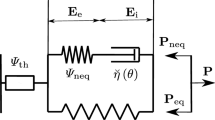Summary
Elastomers are often used in hot and confining environments in which thermomechanical properties are important. It appears that published constitutive models for elastomers are mostly limited to isothermal conditions. In this study, athermohyperelastic constitutive model for near-incompressible elastomers is formulated in terms of the Helmholtz free energy density ϕ. Shear and volume aspects of the deformation are decoupled. Thermomechanical coupling occurs mostly as thermal expansion. Criteria for thermodynamic stability are derived in compact form. As illustration, a particular expression for ϕ is presented which represents the thermomechanical counterpart of the conventional two-term incompressible Mooney-Rivlin model. It is used to analyze several adiabatic problems in a rubber rod.
Similar content being viewed by others
Abbreviations
- A i :
-
matrices appearing inD
- c e, ĉe, c ′e :
-
specific heat at constant strain
- C :
-
Cauchy strain tensor
- C R :
-
reduced Cauchy strain tensor
- C 1,C 2 :
-
coefficients of Mooney-Rivlin model
- c :
-
vectorial counterpart ofC: VEC (C)
- c 2 :
-
vectorial counterpart ofC 2: VEC (C 2)
- D :
-
isothermal tangent stiffness matrix
- e :
-
vectorial counterpart of ɛ: VEC (ɛ)
- ē :
-
deviatoric Lagrangian strain tensor
- e R :
-
reduced deviatoric Lagrangian strain tensor
- e :
-
volume strain
- e T :
-
reduced volume strain
- f :
-
thermal expansion function,=[1+α(T−T 0)/3]−1
- F, F T :
-
deformation gradient tensor
- F R :
-
reduced deformation gradient tensor
- H :
-
Hessian matrix for the Gibbs free energy density ψ
- H′:
-
related toH
- I 1,I 2,I 3 :
-
invariants ofC
- I 1R,I 2R,I 3R :
-
invariants ofC R
- I, I 9 :
-
identity matrix
- i :
-
vectorial counterpart ofI: VEC (I)
- J :
-
determinant ofF
- J R :
-
determinant ofF R
- J T :
-
determinant ofF T
- J 1,J 2 :
-
invariants of ɛ/J R 32
- J 1R,J 2R :
-
invariants of ɛ R /R J 2/3
- k :
-
thermal conductivity coefficient
- K 1,K 2,K 3 :
-
invariants of ɛ/J 2/3
- K 1R,K 2R,K 3R :
-
invariants ofe R/J2/3
- p :
-
hydrostatic pressure
- s :
-
vectorial counterpart of stress σ: VEC (σ)
- s :
-
isotropic stress
- T :
-
(absolute) temperature
- T 0 :
-
reference temperature
- ω:
-
conventional (isothermal) strain energy density (per unit volume)
- α:
-
volumetric thermal expansion coefficient
- β:
-
thermal expansion vector
- ɛ:
-
strain, Lagrangian strain
- η:
-
entropy density
- ϰ:
-
isothermal bulk modulus
- λ:
-
Lagrange multiplier
- λ i :
-
extension ratio
- μ:
-
shear modulus
- χ:
-
stability coefficient
- ϱ:
-
mass density
- σ:
-
stress, 2nd Piola-Kirchhoff stress
- σ i :
-
principal stress
- τ:
-
Cauchy stress
- τ d :
-
deviatoric Cauchy stress
- φ,φ M φ C φ T φ0 :
-
Helmholtz free energy density
- φ i :
-
∂φ/∂I i
- φ ij :
-
∂2φ/∂I i ∂I j
- ψ:
-
Gibbs free energy density
- δ(.):
-
variational operator
- VEC (.):
-
vectorization operator
- ⊗:
-
operator for Kronecker product
References
Dillon, O. W. Jr.: A nonlinear thermoelasticity theory. J. Mech. Phys. Solids10, 123–131 (1962).
Shapery, R. A.: On a thermodynamic constitutive theory and its application to various nonlinear materials. Proc. IUTAM Symposium East Kilbride, (Boley, B., ed.), Wien: Springer, 1968.
ABAQUS Users Manual Ver. 5.2, published by Hibbett, Carlson, and Sorenson, 1993.
Nicholson, D., Nelson, N.: Finite element analysis in design with rubber. Rubber Rev., Rubber Chem. Technol.63, 368–406 (1990).
Ogden, R. W.: Recent advances in the phenomenological theory of rubber elasticity. Rubber Chem. Technol.59, 361–383 (1986).
Oden, J. T.: Finite elements of nonlinear continua. New York: McGraw-Hill 1972.
Cescotto, S., Fonder, G.: A finite element approach for large strains of nearly incompressible rubber-like materials. Int. J. Solids Struct.15, 589–605 (1979).
Hermann, L. R.: Elasticity equations for incompressible and nearly incompressible materials by a variational theorem. AIAA J.3, 1896–1900 (1965).
Nicholson, D. W.: Tangent modulus matrix for finite element analysis of hyperelastic materials. Acta Mech.112, 187–201 (1995).
ANSYS Users Manual Ver. 5, published by Swanson Association, 1993.
Callen, H. B.: Thermodynamics and an introduction to thermostatistics, 2nd ed. New York: Wiley, 1985.
Gent, A. N.: Engineering with rubber: how to design rubber components. New York: Hanser Publishers, 1992.
Author information
Authors and Affiliations
Rights and permissions
About this article
Cite this article
Nicholson, D.W., Lin, B. Theory of thermohyperelasticity for near-incompressible elastomers. Acta Mechanica 116, 15–28 (1996). https://doi.org/10.1007/BF01171417
Received:
Issue Date:
DOI: https://doi.org/10.1007/BF01171417




